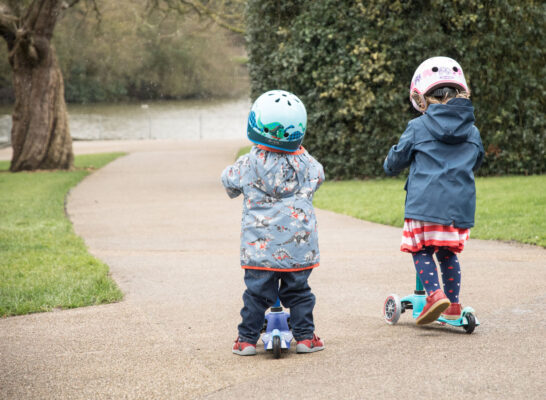HEALTH & WELLBEING
DELIBERATE PLAY GAMES FOR 3 YEAR OLDS
Our illustrated guide provides an easy walk-through of the developmental process and the movement milestones that each child must master at each stage, before moving on to the next stage.
Micro Scooters nursery and preschool product ranges are designed to support the critical developmental stage of 12-36 months. Our Deliberate Play games have been designed for children during this developmental stage, using our products that are best suited for their ability.
Stage 3 explained
Once the toddling stage is over and the child is moving with more balance and co-ordination, and walking with less of a ‘stomping’ gait, they can move onto Stage 3. Children who have experienced a broad base of movement challenges, will be more proficient, confident little ones. They’re now ready to hone their decision making skills and spatial awareness and physically their muscles and core strength. For most children, this stage begins at around 24+m.
The Micro Scooter Mini Micro in Stage 3, with T-bar handle or the Micro Scooter Balance Bike with, or without stabilisers helps them to build confidence as they travel more quickly from A-B. The suspension built into the scooter will protect eager little ones from bumps in the road and The T-Bar handle enables children to hold a suitable upright posture that will build their core strength and help them to control their movements.
The purpose of our games at this stage is to support the child in progressing from confidence physically to mental agility. They will help the child to develop skills such as decision making and communication skills. This will help the child to hone specific movement skills, required for certain sports and expertise at a later stage of development.
DELIBERATE PLAY GAMES FOR STAGE 3
TRAFFIC LIGHT SAYS GO!
Purpose of game: reaction time, balance, communication skills, acceleration/deceleration control, decision making
One person designated the Traffic Light holds a red flag / scarf / jumper and a green flag / scarf / jumper in separate hands
The players line up on scooters, shoulder to shoulder and face the Traffic Light from at least six metres away
The Traffic Light turns around with their back to the scooters, holds up the green flag and shouts, “Green Light,” at which point the scooters can move forward. But without warning, the Traffic Light can hold up the red flag and shout, “Red Light” and whip around to face them. Anyone the Traffic Light sees moving at this point has to return to the starting line.
When a scooter reaches the Traffic Light, the game is over, and the person who made it all the way gets to be the Traffic Light for the next game.
SCOOTER TAG
Purpose of game: fitness, team work, reaction time, balance, change of direction, communication skills, acceleration/deceleration control, decision making
- Similar to tag rugby
- One/two people are ‘It’ and they are on foot
- The people who are ‘It’ have to tag the players on scooters
- Change the game by decreasing or increasing the zone of play available
- When a scooter person is tagged they join the tagging team on foot
- The winner is the last one scooting when everyone else is on foot

RELAY RACES
Purpose of game: reaction time, balance, fitness, acceleration/deceleration control, cognitive challenge with changes in command
Choose a course length for the relay races and mark one end as the starting line and the other as the end line
Divide the children into two groups and stand in parallel lines behind the starting line.
If you have varying ages and stages, ensure there is an equal level of ability on each team
Each relay race utilises the same scooting style eg. scoot with Right foot for three pushes, then swap to left foot for three pushes then repeat; Push once and balance until you come to a stop and repeat
On the shout of “Go!” the first child in each group makes their way down the course to the end line and then returns to the starting line, whereupon the next child can start their leg of the race.
The winning group selects the next racing style
SCOOTER DECK (OF CARDS)
Purpose of game: balance, control, cognitive challenge with shapes
Take a pack of cards
Each suit has a specific task:
Hearts – scoot in a circle
Diamonds – scoot with the left foot
Spades – scoot with right foot
Clubs – push off and balance with both feet on the scooter board and bended knees
When you choose a card the number dictates the amount of times they have to do the task eg: 7 of hearts = Scoot in a circle 7 times
FROZEN BODY
Purpose of game: balance, cognitive challenge, muscle development, core strength
One ‘leader’ calls out a body part and the children have to scoot without moving that part
e they shout right knee and they aren’t allowed to bend the right knee, left elbow and they have to keep their left arm straight for 5 seconds
Body part choices: knees, hips, back, elbow, head and shoulders
SHAPE SPACE – for older children aged 36m+
Purpose of game: balance, acceleration/deceleration control, cognitive challenge with changes in shapes, team work
The children scoot in a circle to start
They scoot around a set number of times and then break out and scoot wherever they like
The leader calls out a shape and they have to all come back together and scoot to form that shape
Someone else is then the leader and it starts again




